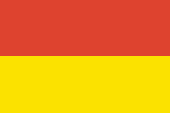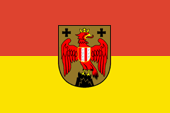Burgenland |
|
|
|
| Übersicht – Contents: | |
Burgenland |
|
|
|
| Übersicht – Contents: | |
Flaggen – Flags: |
|
 |
Landesflagge (Landesfarben) – Flag of the country (colours), Seitenverhältnis – ratio = 2:3, Quelle/Source Wikipedia (D), Färbung/colour nach/by Dr. Peter Diem www.peter-diem.at |
 |
Dienstflagge – official flag, Seitenverhältnis – ratio = 2:3, Quelle/Source Wikipedia (D), Färbung/colour nach/by Dr. Peter Diem www.peter-diem.at |
Bedeutung/Ursprung der Flagge – Meaning/Origin of the Flag: |
|
| Die Flagge des Burgenlands wurde am 25.06.1921 eingeführt und zeigt zwei horizontale Streifen in Rot und Gold und wurde zuletzt am 25.06.1971 offiziell bestätigt. Die Farben der Flagge leiten sich aus den Farben des Wappens ab (Roter Adler auf Gold). | The flag of Burgenland was introduced on 25th of June in 1921 and shows two horizontal stripes in red and gold and was lastly confirmed on 25th of June in 1971. The colours of the flag are derived from the colours of the coat of arms (red eagle on golden ground). |
| Österreich trat 1938 als ein Land dem Deutschen Reich bei. Die föderalen Strukturen spielten keine Rolle, sie wurden komplett durch die Gaue der NSDAP abgelöst, die Länder wurden abgeschafft. Das Burgenland ist zwischen den NS-Gauen "Steiermark" und "Niederdonau" aufgeteilt. |
Austria joined the German
Empire in 1938 as one country. The federal structures played no role, they
were completely replaced by the NSDAP districts (NS-Gau), the countries were
abolished. Burgenland is divided between the disticts of "Styria" and "Niederdonau". |
| Die Flaggen der Österreichischen Bundesländer werden mit oder ohne Wappen gezeigt. Amtlich verwendet, tragen sie immer das Wappen, jedoch darf auch die Bevölkerung Flaggen mit Wappen verwenden. | The flags
of the Federal States of Austria are used with or without the coat of arms. For official use, however, they always show it. The general population is permitted to use this format as well. |
| Für die Farben der Flaggen der österreichischen Bundesländer scheint es keine gesetzlichen Regelungen zu geben, sie werden, da offenbar nicht definiert, in der Praxis in einem gewissen Standardbereich wiedergegeben. Der österreichische Publizist und Medienwissenschaftler Dr. Peter Diem gibt aber Empfehlungen für die Wiedergabe der Farben: Für Burgenland ein helles Rot, am ehesten Pantone 179 entsprechend, und Gelb als 100% Y. |
There do not seem to be
any legal regulations for the colours of the flags of the Austrian federal
states; since they are apparently not defined, they are reproduced in
practice within a usual standard range. However, the Austrian publicist and media scientist Dr. Peter Diem gives recommendations for the reproduction of the colours: For Burgenland, a bright red, most likely corresponding to Pantone 179, and yellow as 100% Y. |
| Quelle/Source: Dr. Peter Diem austria-forum.org, Wikipedia (D), Flaggen Enzyklopädie, Volker Preuß | |
Wappen – Coat of Arms: |
|
 |
seit/since 1922, Wappen von Burgenland – coat of arms of Burgenland, Quelle/Source nach/by: Wikipedia (D) |
Bedeutung/Ursprung des Wappens – Meaning/Origin of the Coat of Arms: |
|
| Das Wappen des Burgenlandes wurde 1922 eingeführt. Es zeigt einen roten Adler auf goldenem Grund, der auf einem Felsen sitzt. Er trägt ein Brustschild, das einen dreifach gespaltenen Schild in den Farben Rot und Silber zeigt. Dieses Wappen kombiniert die Wappen der bedeutendsten Adelsgeschlechter der Region, der Grafen von Güssing-Bernstein und der Grafen von Mattersdorf-Forchtenstein. | The coat of arms of Burgenland was introduced in 1922. It shows a red eagle on golden ground which sits on a rock. It carrys a chest shield which shows a threefold clefted shield in the colours red und silver. That coat of arms combines the coat of arms of the most important nobility lineages of the region, the Counts of Guessing-Bernstein and the Counts of Mattersdorf-Forchtenstein. |
| Quelle/Source: Wikipedia (D) | |
Landkarte – Map: |
| Die Bundesländer Österreichs – the federal counties of Austria: |
|
Burgenland • Kärnten
(Carinthia) • Niederösterreich (Lower Austria) |
| Source/Quelle: Volker Preuß |
| die Kronländer Österreich-Ungarns – Crown Lands of Austria-Hungary: |
|
| Quelle/Source: Volker Preuß |
Zahlen und Fakten – Numbers and Facts: |
|
|
|
|
|
|
|
|
|
|
|
|
|
|
|
|
|
|
|
|
Geschichte: |
| ca. 1300
v.Chr. · Besiedlung durch Illyrer ca. 400 v.Chr. · Besiedlung durch Kelten 15 v.Chr. · römische Eroberung, Errichtung der Provinz Pannonia superior 233 · Invasion der Quaden 4./5. Jhd. · das Burgenland gehört zum Reich der Ostgoten 409–452 · Hunneneinfälle 6. Jhd. · das Burgenland gehört zum Reich der Langobarden seit 568 · Abzug der Langobarden, Besiedlung durch Awaren und Slawen 788 · Eroberung durch das Frankenreich der Karolinger 795 · Bildung der "Awarischen Mark" 843/870/880 · bei der Teilung des Frankenreiches kommt die Awarische Mark zum Ostfänkischen Königreich (später Deutsches Reich genannt) 896 · Invasion der Ungarn, das Gebiet des heutigen Burgenlands wird Ungarn eingegliedert 11.–13. Jhd. · Besiedlung durch Deutsche 1526 · nach der Schlacht von Mohács erwerben die Habsburger die Ungarische Krone, das Königreich Ungarn (einschließlich des Burgenlands) bleibt zwischen Österreich und den Türken als schmaler Streifen bestehen, Ungarn selbst geht zu 80% an die Türken 01.11.1918 · Infolge der österreichisch-ungarischen Niederlage im ersten Weltkrieg spaltet sich Ungarn als selbstständig ab, das Burgenland verbleibt zunächst bei Ungarn 10.09.1919 · Friedensvertrag von Saint-Germain, Anerkennung Ungarns durch Österreich, jedoch wird das Burgenland wegen des hohen Anteils deutscher Bevölkerung und nach einer Volksabstimmung Österreich zugesprochen, nur der Kreis Ödenburg (Sopron) verbleibt bei Ungarn 13.03.1938 · Anschluss ganz Österreichs an das Deutsche Reich, das Burgenland wird zwischen den NS-Gauen Niederdonau und Steiermark aufgeteilt 27.04.1945 · Proklamation der Republik Österreich "Zweite Republik", das Burgenland wird als österreichisches Bundesland wiedererrichtet, bleibt jedoch bis 1955 von sowjetischen Truppen besetzt 1955 · Abzug der Besatzungstruppen |
History: |
| ca. 1300
B.C. · settlement by Illyrians ca. 400 B.C. · settlement by Celts 15 B.C. · Roman conquest, establishment of the Province of Pannonia superior 233 · invasion of the Quades 4th/5th cent. · the Burgenland belongs to the Empire of the Eastern Goth 409–452 · invasions of the Huns 6th cent. · the Burgenland belongs to the Empire of the Langobardes since 568 · migration of the Langobardes, settlement by Awares and Slavs 788 · conquest by the Frankish Empire of the Carolingians 795 · establishment of the "Awarian Mark" 843/870/880 · at the division of the Frankish Empire comes the Awarian Mark to the East Frankish Empire (later named German Empire) 896 · Invasion of the Hungarians, the area of the today’s Burgenland becomes affiliated to Hungary 11th–13th cent. · settlement by Germans 1526 · the Habsburgs acquire from the House of Luxemburg by inheritance Bohemia, Silesia and the Lausitz, as well as after the Battle of Mohács the Hungarian Crown, the Kingdom of Hungary (including Burgenland) remains between Austria and the Turks as slender stripe, Hungary itself comes to 80% to the Turks 1st of January 1918 · due to the Austria-Hungaryn defeat in the First World War separates Hungary as independent, the Burgenland remains initially at Hungary 10th of September 1919 · Peace Treaty of Saint-Germain, recognition of Hungary by Austria, but Burgenland becomes adjudged to Austria because of the high contingent of German population and after a plebiscite, only the District of Oedenburg (Sopron) remains at Hungary 13th of March 1938 · Annexation of Austria to the German Empire, Burgenland becomes partitioned between the the NS-Gau's of Lower Danube (Niederdonau) and Steiermark 27th of April 1945 · proclamation of the Republic of Austria "Second Republic", Burgenland becomes re-established as Austrian federal country, but stays occupied by Soviet troops to 1955 1955 · withdrawal of the occupation troops |
| Quelle/Source: Atlas zur Geschichte, Wikipedia (D), World Statesmen, RetroBib Retrobibliothek, Discovery '97, Volker Preuß |
Ursprung des Landesnamens – Origin of the Country's Name: |
|
| Der Name "Burgenland" geht auf die Namen der ehemals ungarischen Kreise zurück, aus denen das Burgenland 1919 gebildet wurde: Ödenburg, Eisenburg und Wieselburg | The name "Burgenland" has its roots in the names of the former Hungarian districts from which Burgenland was formed in 1919: Oedenburg, Eisenburg and Wieselburg |
| Quelle/Source: Wikipedia (D) | |
| • Reich der Österr. Habsburger (bis 1804) • Kaiserreich Österreich (1804–1867) • Österreich-Ungarn (1867–1918) • Republik Österreich (seit 1918) |
• Empire of the Austrian Habsburgs (to 1804) • Empire of Austria (1814–1867) • Austria-Hungary (1867–1918) • Republic of Austria (since 1918) |